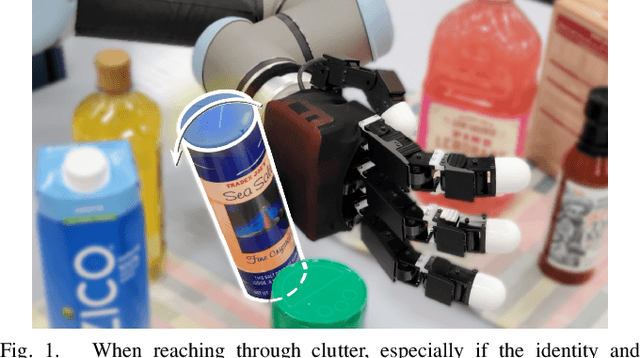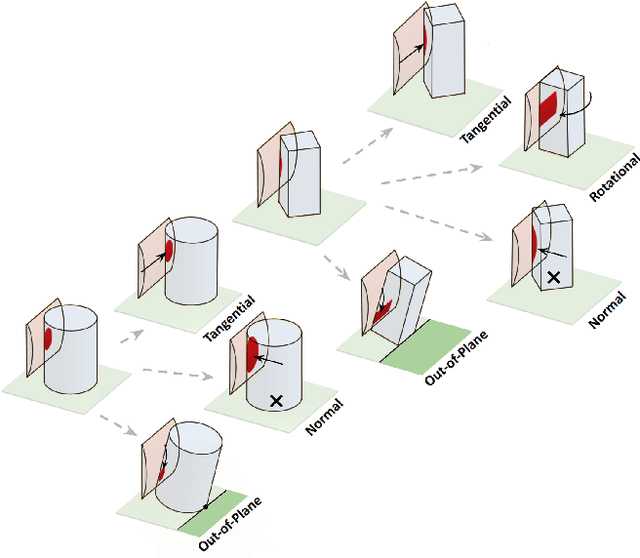Mark R. Cutkosky
CoinFT: A Coin-Sized, Capacitive 6-Axis Force Torque Sensor for Robotic Applications
Mar 25, 2025Abstract:We introduce CoinFT, a capacitive 6-axis force/torque (F/T) sensor that is compact, light, low-cost, and robust with an average mean-squared error of 0.11N for force and 0.84mNm for moment when the input ranges from 0~10N and 0~4N in normal and shear directions, respectively. CoinFT is a stack of two rigid PCBs with comb-shaped electrodes connected by an array of silicone rubber pillars. The microcontroller interrogates the electrodes in different subsets in order to enhance sensitivity for measuring 6-axis F/T. The combination of desirable features of CoinFT enables various contact-rich robot interactions at a scale, across different embodiment domains including drones, robot end-effectors, and wearable haptic devices. We demonstrate the utility of CoinFT on drones by performing an attitude-based force control to perform tasks that require careful contact force modulation. The design, fabrication, and firmware of CoinFT are open-sourced at https://hojung-choi.github.io/coinft.github.io/.
TacCap: A Wearable FBG-Based Tactile Sensor for Seamless Human-to-Robot Skill Transfer
Mar 03, 2025Abstract:Tactile sensing is essential for dexterous manipulation, yet large-scale human demonstration datasets lack tactile feedback, limiting their effectiveness in skill transfer to robots. To address this, we introduce TacCap, a wearable Fiber Bragg Grating (FBG)-based tactile sensor designed for seamless human-to-robot transfer. TacCap is lightweight, durable, and immune to electromagnetic interference, making it ideal for real-world data collection. We detail its design and fabrication, evaluate its sensitivity, repeatability, and cross-sensor consistency, and assess its effectiveness through grasp stability prediction and ablation studies. Our results demonstrate that TacCap enables transferable tactile data collection, bridging the gap between human demonstrations and robotic execution. To support further research and development, we open-source our hardware design and software.
Whisker-Inspired Tactile Sensing: A Sim2Real Approach for Precise Underwater Contact Tracking
Oct 17, 2024



Abstract:Aquatic mammals, such as pinnipeds, utilize their whiskers to detect and discriminate objects and analyze water movements, inspiring the development of robotic whiskers for sensing contacts, surfaces, and water flows. We present the design and application of underwater whisker sensors based on Fiber Bragg Grating (FBG) technology. These passive whiskers are mounted along the robot$'$s exterior to sense its surroundings through light, non-intrusive contacts. For contact tracking, we employ a sim-to-real learning framework, which involves extensive data collection in simulation followed by a sim-to-real calibration process to transfer the model trained in simulation to the real world. Experiments with whiskers immersed in water indicate that our approach can track contact points with an accuracy of $<2$ mm, without requiring precise robot proprioception. We demonstrate that the approach also generalizes to unseen objects.
Locomotion as Manipulation with ReachBot
Jul 01, 2024Abstract:Caves and lava tubes on the Moon and Mars are sites of geological and astrobiological interest but consist of terrain that is inaccessible with traditional robot locomotion. To support the exploration of these sites, we present ReachBot, a robot that uses extendable booms as appendages to manipulate itself with respect to irregular rock surfaces. The booms terminate in grippers equipped with microspines and provide ReachBot with a large workspace, allowing it to achieve force closure in enclosed spaces such as the walls of a lava tube. To propel ReachBot, we present a contact-before-motion planner for non-gaited legged locomotion that utilizes internal force control, similar to a multi-fingered hand, to keep its long, slender booms in tension. Motion planning also depends on finding and executing secure grips on rock features. We use a Monte Carlo simulation to inform gripper design and predict grasp strength and variability. Additionally, we use a two-step perception system to identify possible grasp locations. To validate our approach and mechanisms under realistic conditions, we deployed a single ReachBot arm and gripper in a lava tube in the Mojave Desert. The field test confirmed that ReachBot will find many targets for secure grasps with the proposed kinematic design.
Navigation and 3D Surface Reconstruction from Passive Whisker Sensing
Jun 10, 2024Abstract:Whiskers provide a way to sense surfaces in the immediate environment without disturbing it. In this paper we present a method for using highly flexible, curved, passive whiskers mounted along a robot arm to gather sensory data as they brush past objects during normal robot motion. The information is useful both for guiding the robot in cluttered spaces and for reconstructing the exposed faces of objects. Surface reconstruction depends on accurate localization of contact points along each whisker. We present an algorithm based on Bayesian filtering that rapidly converges to within 1\,mm of the actual contact locations. The piecewise-continuous history of contact locations from each whisker allows for accurate reconstruction of curves on object surfaces. Employing multiple whiskers and traces, we are able to produce an occupancy map of proximal objects.
ReachBot Field Tests in a Mojave Desert Lava Tube as a Martian Analog
May 23, 2024



Abstract:ReachBot is a robot concept for the planetary exploration of caves and lava tubes, which are often inaccessible with traditional robot locomotion methods. It uses extendable booms as appendages, with grippers mounted at the end, to grasp irregular rock surfaces and traverse these difficult terrains. We have built a partial ReachBot prototype consisting of a single boom and gripper, mounted on a tripod. We present the details on the design and field test of this partial ReachBot prototype in a lava tube in the Mojave Desert. The technical requirements of the field testing, implementation details, and grasp performance results are discussed. The planning and preparation of the field test and lessons learned are also given.
Using Fiber Optic Bundles to Miniaturize Vision-Based Tactile Sensors
Mar 12, 2024



Abstract:Vision-based tactile sensors have recently become popular due to their combination of low cost, very high spatial resolution, and ease of integration using widely available miniature cameras. The associated field of view and focal length, however, are difficult to package in a human-sized finger. In this paper we employ optical fiber bundles to achieve a form factor that, at 15 mm diameter, is smaller than an average human fingertip. The electronics and camera are also located remotely, further reducing package size. The sensor achieves a spatial resolution of 0.22 mm and a minimum force resolution 5 mN for normal and shear contact forces. With these attributes, the DIGIT Pinki sensor is suitable for applications such as robotic and teleoperated digital palpation. We demonstrate its utility for palpation of the prostate gland and show that it can achieve clinically relevant discrimination of prostate stiffness for phantom and ex vivo tissue.
Feed Me: Robotic Infiltration of Poison Frog Families
May 23, 2023Abstract:We present the design and operation of tadpole-mimetic robots prepared for a study of the parenting behaviors of poison frogs, which pair bond and raise their offspring. The mission of these robots is to convince poison frog parents that they are tadpoles, which need to be fed. Tadpoles indicate this need, at least in part, by wriggling with a characteristic frequency and amplitude. While the study is in progress, preliminary indications are that the TadBots have passed their test, at least for father frogs. We discuss the design and operational requirements for producing convincing TadBots and provide some details of the study design and plans for future work.
Going In Blind: Object Motion Classification using Distributed Tactile Sensing for Safe Reaching in Clutter
Sep 30, 2022



Abstract:Robotic manipulators navigating cluttered shelves or cabinets may find it challenging to avoid contact with obstacles. Indeed, rearranging obstacles may be necessary to access a target. Rather than planning explicit motions that place obstacles into a desired pose, we suggest allowing incidental contacts to rearrange obstacles while monitoring contacts for safety. Bypassing object identification, we present a method for categorizing object motions from tactile data collected from incidental contacts with a capacitive tactile skin on an Allegro Hand. We formalize tactile cues associated with categories of object motion, demonstrating that they can determine with $>90$% accuracy whether an object is movable and whether a contact is causing the object to slide stably (safe contact) or tip (unsafe).
Deep Learning Classification of Touch Gestures Using Distributed Normal and Shear Force
Sep 30, 2022



Abstract:When humans socially interact with another agent (e.g., human, pet, or robot) through touch, they do so by applying varying amounts of force with different directions, locations, contact areas, and durations. While previous work on touch gesture recognition has focused on the spatio-temporal distribution of normal forces, we hypothesize that the addition of shear forces will permit more reliable classification. We present a soft, flexible skin with an array of tri-axial tactile sensors for the arm of a person or robot. We use it to collect data on 13 touch gesture classes through user studies and train a Convolutional Neural Network (CNN) to learn spatio-temporal features from the recorded data. The network achieved a recognition accuracy of 74% with normal and shear data, compared to 66% using only normal force data. Adding distributed shear data improved classification accuracy for 11 out of 13 touch gesture classes.
 Add to Chrome
Add to Chrome Add to Firefox
Add to Firefox Add to Edge
Add to Edge